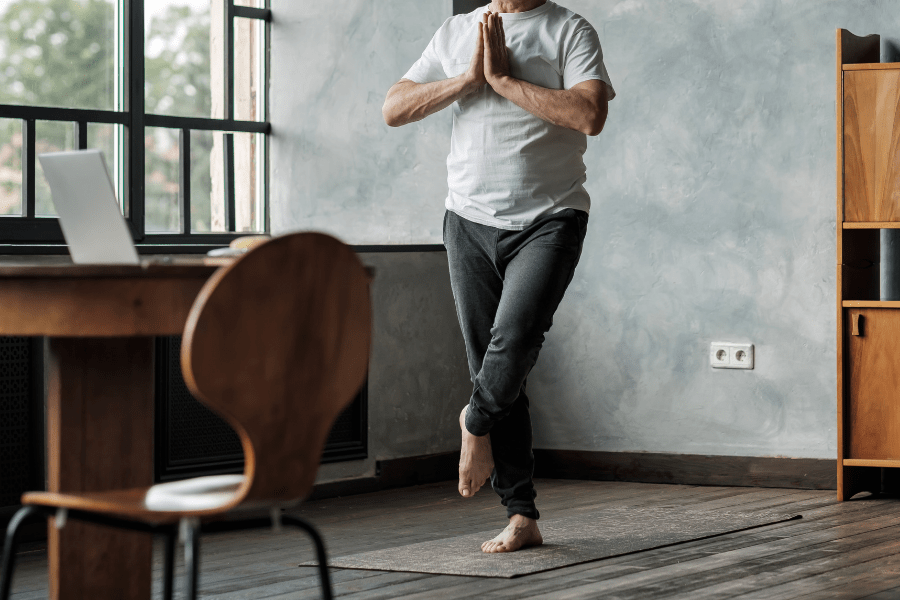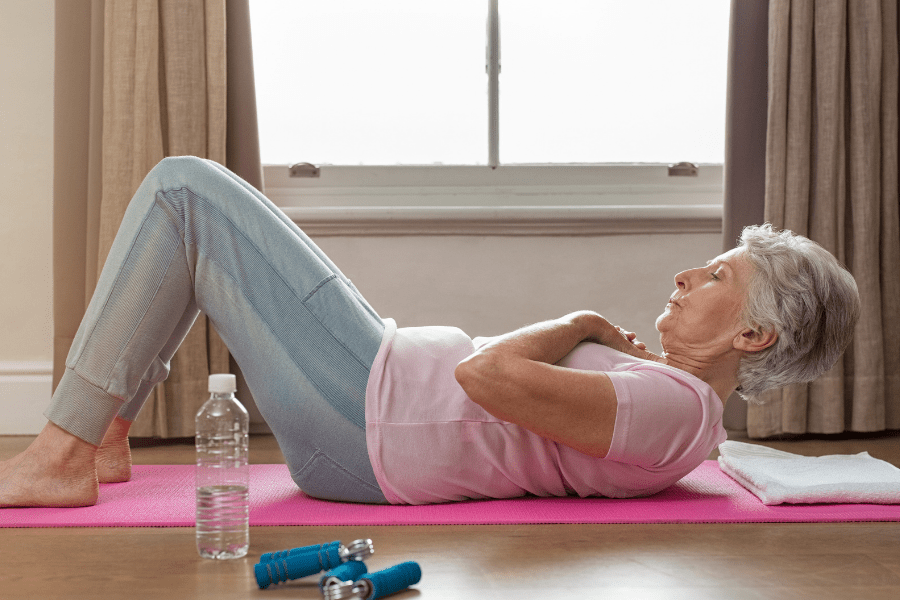
These indoor exercises for seniors make it easy to get the recommended amount of physical activity while staying inside. Here are some ideas to get you started.
Simple And Easy Indoor Exercises For Seniors
- It’s no secret that exercise can improve your overall health and well-being. Staying active is challenging enough, but it can get even more difficult as we age. This can be a problem since inactive lifestyles among seniors can worsen mobility, flexibility, and even independence.
- For aging adults, it’s crucial to exercise at least 150 minutes every week. Staying active can help prevent ongoing diseases, better your mood, improve mobility and balance, and decrease the chances of injury. In addition, indoor exercises for seniors make it easy to get the recommended amount of activity while staying inside. So to help you get started, check out some of these ideas.
Before trying these indoor exercises for seniors, read these tips:
- Before beginning any exercise regimen, be sure to talk to your doctor.
- Look at different activities and note the ones you think you will enjoy the most. Doing so will encourage you to stick with your regimen.
- Start slowly and don’t overdo it – you’ll get where you want to be soon enough!
- Drink plenty of water.
- Wear comfortable clothing.
- Make sure you stretch beforehand.
- If you feel any pain, stop what you are doing immediately.
6 Indoor Exercises For Seniors
Cycling
A low-impact activity like cycling is one of the best indoor exercises for seniors because it promotes a healthy cardiovascular system and strengthens the legs while reducing joint stress. More muscular legs improve balance and stability, which supports autonomy and independence.
If you have a stationary bicycle at home, why not make it part of your routine? For example, try using it while watching the morning news or one of your regular shows. Doing so might make it easier to make this activity a regular part of your routine.
But if you don’t have a stationary bike, you could consider joining a gym or fitness center. Not only would classes make exercise more fun, but they’re a great way to meet new people. In addition, by getting out and working out with others, you promote your physical and social well-being.

Yoga

There are many things to love about yoga, and the flexibility it offers (literally and metaphorically) makes it a great indoor exercise for seniors.
To begin with, you don’t have to be a professional to do yoga or even be super flexible. Secondly, if you have limited mobility, you can modify this activity by trying chair yoga.
In addition, it doesn’t take an expensive class or studio membership to start doing yoga. As long as you have space in your home, you can find hundreds of online yoga videos that will guide you through your workout.
Some older adults may perceive yoga as something intended for younger people. However, researchers at the National Center for Complementary and Integrative Health (NCCIH) at NIH found that yoga steadily gained popularity among seniors.
According to their 2020 clinical digest, the rate of people 65 and older who practiced yoga was:
- 6.7% in 2017
- 3.3% in 2012
- 2% in 2007
- 1.3% in 2002
As you’ve probably heard before, yoga offers many benefits. Although more research is needed to prove a direct link between yoga and improved wellbeing, early studies do indicate that it promotes positive benefits, such as:
- Lower stress
- Better balance
- Weight management
- Higher mental resilience
- Fewer nicotine cravings
Before you try yoga for the first time, talk to your doctor and the instructor. Also, make sure to take it slow. It’s best to begin with a class suitable to your levels, such as senior yoga or gentle yoga, because you can get more personal guidance and learn proper form.
Balance Exercises
Besides lowering your risk of fall-related injuries, incorporating balance exercises with other physical activities offers many benefits, such as improvements in:
- Reaction time
- Coordination
- Muscle composition
- Bone strength
- Brain function
You can find balance classes offered in many places, such as senior community centers, the YMCA, fitness facilities, religious organizations, and more. But suppose you’re homebound or simply prefer to exercise at home. In that case, there are many balance-improving activities you can try, such as these three exercises suggested by the American College of Sports Medicine:
- Stand with one foot in front of another
- Slowly picking one foot off the floor
- Shifting your weight in different directions
Try these exercises between commercial breaks while watching TV. Of course, make sure that you put your safety first. If necessary, only perform balance exercises when someone else is home with you.

Walking

Walking isn’t always the first thing you think of when you think of workouts. However, it’s actually a simple and great way to incorporate movement into your routine. Daily walks stand to offer many benefits to seniors in particular, such as lower:
- Risks of heart disease
- Blood sugar
- Joint pain
- Rates of depression and anxiety
- Risk of illness
For days when you want to get out of the house but the weather isn’t conducive to outside walks, consider indoor options. For example, museums, malls, or other indoor public spaces with plenty of space are perfect for getting the recommended 2.5 hours of walking into your week.
Resistance Training
Resistance training techniques are great indoor exercises for seniors. Several studies have found that regular strength training improves older adults’ ability to perform activities of daily living (ADL) as well as:
- Balance
- Bone density
- Independence
- Vitality
- Resistance against chronic disease
- Mental and physical wellbeing
- Cognitive health
But despite the benefits, only 8.7% of seniors regularly engaged in resistance exercises in 2016, according to the National Center for Health Statistics.

Additionally, a 2016 study published in the Journal of Aging and Physical Activity noted reasons older adults shied away from muscle-strengthening activities included “safety, fear, health concerns, pain, fatigue, and lack of social support.”
These reasons behind many seniors’ hesitation are understandable. In addition, some may feel intimidated or that they don’t have the right resources. But fortunately, you don’t need a gym membership or an at-home gym to practice resistance training. Instead, using your body weight can build muscle and start feeling better. Try these exercises to see how they work for you:
- Push-ups (If you can’t do them on the floor, wall push-ups work just as well)
- Pull-ups
- Crunches or sit-ups
- Leg squats
- Press your back against a wall. Then, bend your knees as if sitting on an invisible chair and hold as long as possible.
MeetCaregivers Can Help
Sticking to a wellness routine is easier when you have a companion to support you. So if you or an aging loved one needs assistance with transportation, meals, mobility, or other ADLs, we can help.
We provide qualified professionals to assist with whatever needs you may have. So contact us at info@meetcaregivers.com or call 1-888-541-1136. After that, you can read our post about hiring through MeetCaregivers and reach out if you are interested in learning more about our services.
We update our blog every Monday, so check in regularly to find new and helpful information about senior care.
- Excellence In Fitness. (2022, March 16). 7 Benefits of Walking Every Day for Older Adults. ExcellenceInFitness.com. Retrieved April 14, 2022, from https://www.excellenceinfitness.com/blog/7-benefits-of-walking-every-day-for-older-adults
- Fragala, M. S., Cadore, E. L., Dorgo, S., Izquierdo, M., Kraemer, W. J., Peterson, M. D., & Ryan, E. D. (2019, August). Resistance Training for Older Adults: Position Statement From the National Strength and Conditioning Association. Journals.LWW.com. Retrieved April 14, 2022, from https://journals.lww.com/nsca-jscr/fulltext/2019/08000/resistance_training_for_older_adults__position.1.aspx#JCL-P-24
- Garrard, J., Handy, S., & Dill, J. (2012). City cycling. Women in Cycling (Pucher, J., Buehler, R., eds.), MIT Press, Cambridge, MA, 211-234.
- LeWine, H. E. (2013, October 31). Balance training seems to prevent falls, injuries in seniors. Health.Harvard.edu. Retrieved April 14, 2022, from https://www.health.harvard.edu/blog/balance-training-seems-to-prevent-falls-injuries-in-seniors-201310316825
- mmLearn.org. (2020, April 15). Nine Benefits of Yoga for Seniors. mmLearn.org. Retrieved April 13, 2022, from https://training.mmlearn.org/blog/nine-benefits-of-yoga-for-seniors
- U.S. Department of Health and Human Services. (2020, February). Yoga for Health: What the Science Says. National Center for Complementary and Integrative Health. Retrieved April 13, 2022, from https://www.nccih.nih.gov/health/providers/digest/yoga-for-health-science#yoga-for-older-adults
